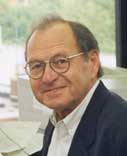Social psychologist Robert Zajonc, who conducted groundbreaking research on the complexities of social life, died after a five-year battle with pancreatic cancer Dec. 3 in Palo Alto, Calif. He was 85.

Born in Lodz, Poland, Zajonc’s parents were killed during World War II in a German air raid when he was 15 and he spent several of the war years in Nazi work camps until he escaped by walking 900 kilometers to Quimper, France. He came to the United States after the war, receiving his bachelor’s, master’s and doctoral degrees from U-M.
During his tenure at the University, he served as director of the Institute for Social Research (ISR) and of the ISR Research Center for Group Dynamics. After he retired in 1994, he joined the Stanford University faculty as an emeritus professor.
It was at U-M that Zajonc conducted a series of well-known studies that made him one of the most widely cited and influential social psychologists in the world. The scope of his work ranged from the impact of familiarity on attitudes to the emergence of individual preferences and the influence of family dynamics on intellectual performance.
“Robert Zajonc was one of the most distinguished social psychologists in history,” says psychologist Richard Nisbett, a long-time colleague. “The range of his interests and accomplishments is virtually without parallel. His work was central to many different fields of psychology. His students include some of the most highly regarded social psychologists in the world. His piercing intelligence was matched by his generosity of spirit.”
One of his early lines of research established how the presence of others influenced performance for better and for worse, in creatures from cockroaches to college sophomores. Zajonc showed that people performed tasks they knew faster and better when they were with other people, and that they made more mistakes at new tasks than they did when alone.
He also conducted a series of studies that belie the common belief that familiarity breeds contempt. He showed that mere exposure to a stimulus, in and of itself, led people to rate that stimulus more positively. He demonstrated that this was the case using stimuli as diverse as faces, Turkish words and Chinese ideograms.
Zajonc also conducted a series of studies on social behavior that explored the relationship between feeling and thinking. He maintained that preferences need no inferences, that feelings precede cognition, and that affect and cognition operate independently of each other.
But it was his work on the link between birth order, family size and intelligence, conducted with U-M psychologist Gregory Markus that attracted the most popular attention. In the mid-1970s, Zajonc and Markus conducted research showing that as family size increases, the overall IQ of the family drops. First-born children, born into adult-only families, tend to have higher IQs than younger siblings, the research showed, while the youngest child in the family tends to have the lowest IQ.
During his long career, Zajonc received many honors and awards. In 1989 he received the Distinguished Scientific Contribution Award from the American Psychological Association. He was a member of the American Academy of Arts and Sciences, and earned Guggenheim, Fulbright and Rockefeller fellowships. He held honorary degrees from the University of Louvain and the University of Warsaw, where he established a partner institution with ISR to advance research, scholarship and teaching designed to improve understanding of societies in transition.
Zajonc is survived by his wife Hazel Markus of Palo Alto, and their daughter Krysia Zajonc of Costa Rica; sons Peter, of New York, Michael of Belgium and Joseph of Seattle, and their mother Donna Zajonc of Ann Arbor; and grandchildren Jonathan, Oliver, Zoe and Lucy.
A memorial service was held Dec. 6 at Stanford; another memorial is planned for Jan. 12 in Ann Arbor. For more information, contact Mary Guttman at cullen@umich.edu.
The family requests that memorial contributions be made to the Robert Zajonc Scholars Fund at ISR.

